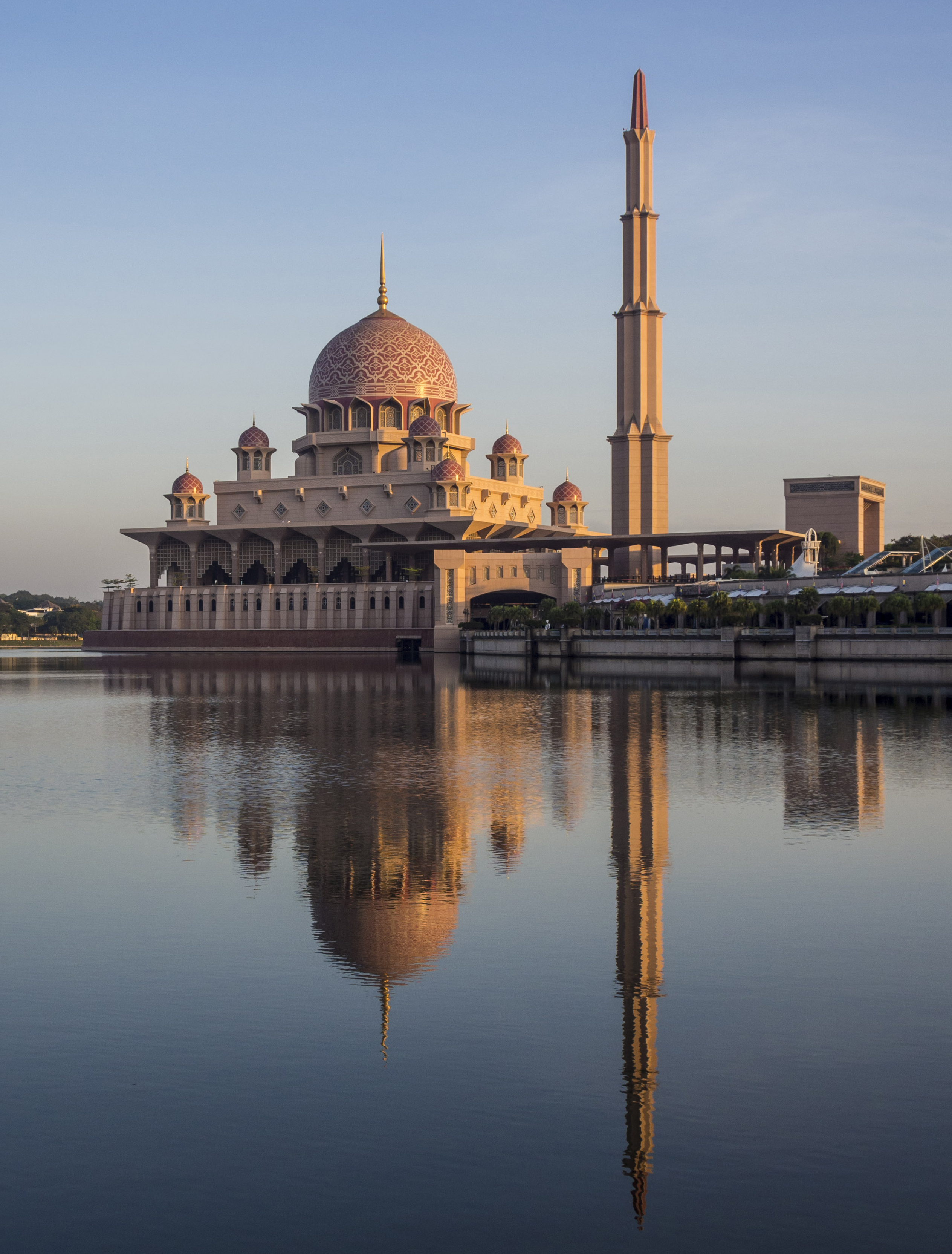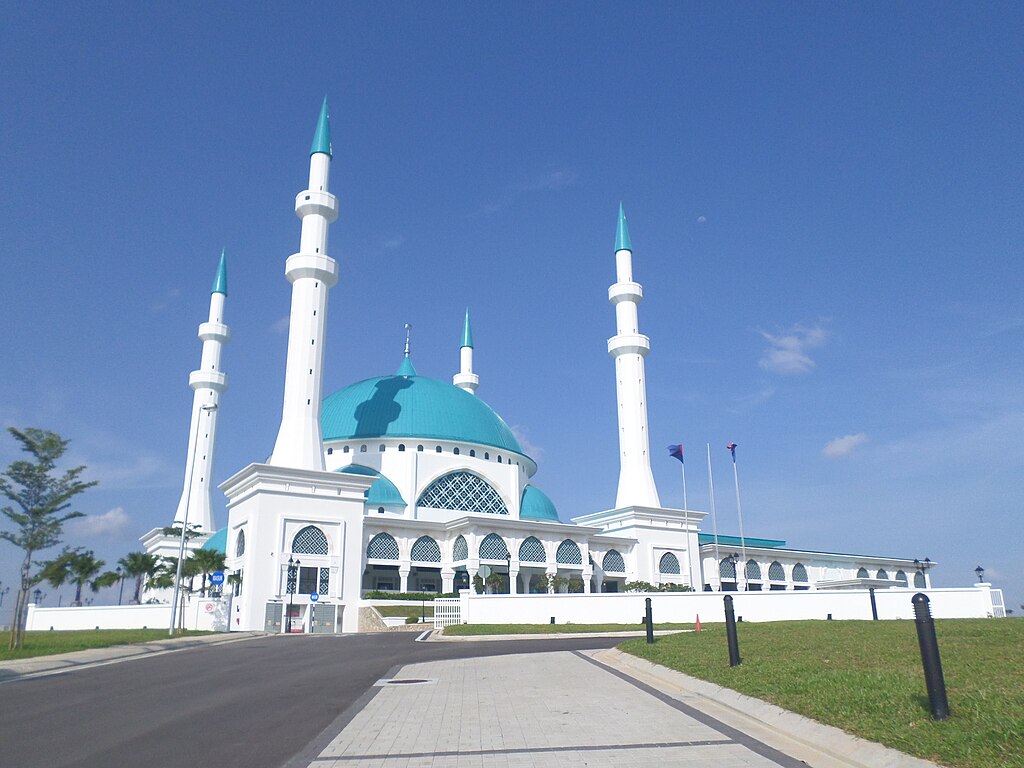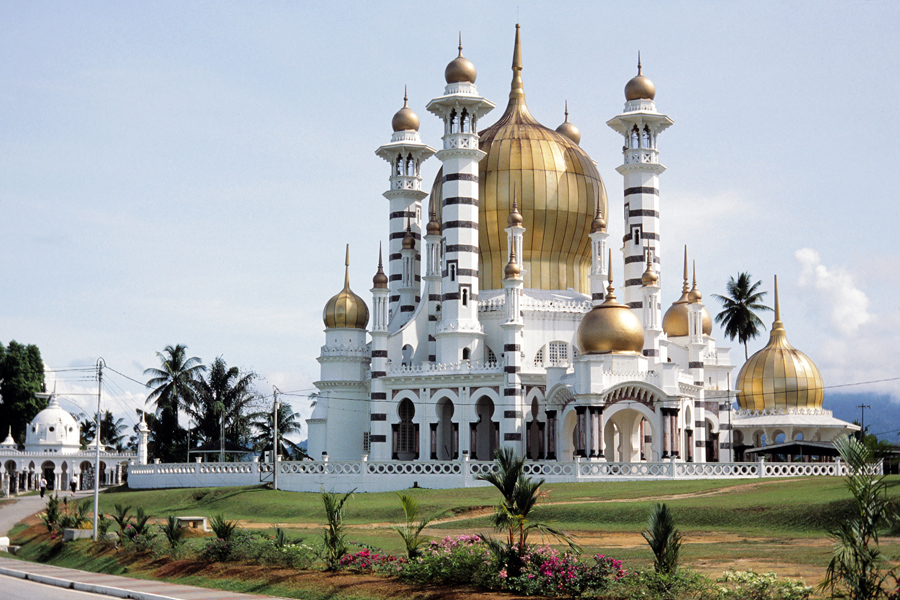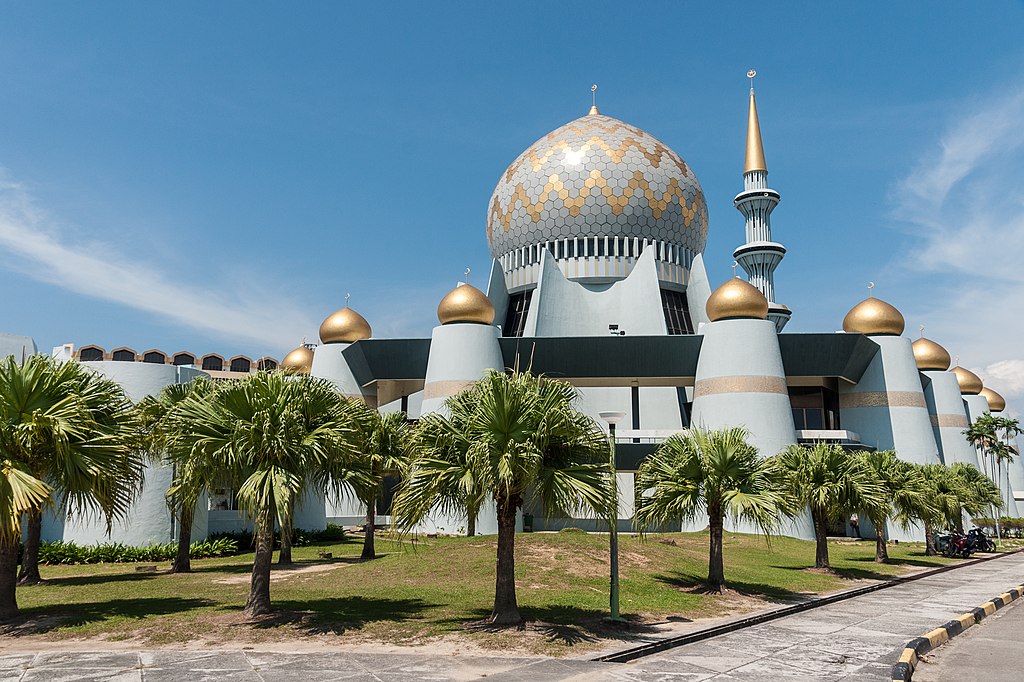12 Most Stunning Mosques in Malaysia with Unique Architecture
I’ve always found houses of worship to be some of the most beautiful and peaceful places to visit when I travel. And Malaysia, being a predominantly Muslim country, is home to numerous mosques. Whether you’re in a big city or a quiet seaside town, chances are there’s a mosque nearby that will stop you in your tracks — sometimes because of its sheer size, sometimes because of its stunning detail, and sometimes simply because of the atmosphere.
You don’t have to be religious to appreciate the calm or the craftsmanship. So if you’re ever in the country and wondering what to see beyond the usual tourist spots, here are some of what I think are the most beautiful and unique mosques in Malaysia, plus some tips for visiting.
Table of Contents
Toggle1. Masjid Putra (Putrajaya)
Also known as: The Pink Mosque
Located in Putrajaya, Malaysia’s administrative capital, this iconic mosque is impossible to miss, thanks to its rose-tinted dome and unique pink granite exterior. It sits right by the edge of Putrajaya Lake, and from a distance, it almost looks like it’s floating.
Inside, the main prayer hall is massive, with high ceilings, soft lighting, and subtle detailing that gives the place a quiet, peaceful atmosphere. It can hold up to 15,000 worshippers at a time. The design of the mosque blends traditional Malay and Middle Eastern styles, but the real standout feature is the pink dome, which sets it apart from other mosques in the country.
📸 Best photo spot: The lakeside promenade behind the mosque.
Persiaran Persekutuan, Presint 1, 62502 Putrajaya, Wilayah Persekutuan Putrajaya2. Masjid Tuanku Mizan Zainal Abidin (Putrajaya)
Also known as: The Iron Mosque
Just a short distance from Masjid Putra is another architectural standout: Masjid Tuanku Mizan Zainal Abidin. While Masjid Putra is known for its warm pink tones, this one takes on a cooler, more modern look with its sleek steel structure and open design. It was officially opened in 2009 and can accommodate up to 20,000 worshippers.
The nickname “Iron Mosque” comes from the fact that over 70% of its structure is made from steel. Instead of air-conditioning, the mosque relies on an open concept design and a clever ventilation system that lets in natural wind and light, keeping the space cool and bright. The main prayer hall is wide and airy, with floor-to-ceiling glass that offers views of the surrounding city and lake.
There aren’t any minarets or traditional domes here — its design is modern and minimalist, giving it a very different feel from most mosques in the country.
📸 Best photo spot: From the pedestrian bridge nearby or the lakeside promenade.
📍 25, Jalan Tuanku Abdul Rahman, Presint 3, 62100 Putrajaya, Wilayah Persekutuan Putrajaya
3. Masjid Wilayah Persekutuan (Kuala Lumpur)
Also known as: The Federal Territory Mosque
Tucked away in the quieter enclave of Jalan Duta, Masjid Wilayah Persekutuan is often called one of Kuala Lumpur’s best-kept secrets. Despite its grandeur, it doesn’t see as many tourists as Putrajaya or Kuala Lumpur’s other mosques, which makes the experience here feel more personal and peaceful.
The mosque’s design is heavily inspired by classical Ottoman architecture, drawing visual parallels to the Blue Mosque in Istanbul. Its features a massive turquoise dome, elegant archways, and large, symmetrical courtyards. The mosque can accommodate over 17,000 worshippers at a time.
Jln Tuanku Abdul Halim, Kompleks Kerajaan, 50480 Kuala Lumpur, Wilayah Persekutuan Kuala Lumpur4. Masjid Negara (Kuala Lumpur)
Also known as: The National Mosque of Malaysia
Masjid Negara is one of the most important mosques in Malaysia, both historically and symbolically. Built in 1965, it was meant to mark the country’s independence and to reflect a modern, forward-looking Malaysia. The mosque can hold up to 15,000 worshippers and sits on 13 acres of land near many of Kuala Lumpur’s main attractions.
Its most recognizable feature is the 73-metre-high minaret and a large, star-shaped main roof that was designed to look like an open umbrella — a symbol of shelter and protection. There’s also a reflecting pool and well-maintained gardens around the mosque, making it a peaceful place to walk around even if you don’t go inside.
Best photo spot: From the garden walkway outside the prayer hall. Jalan Perdana, Tasik Perdana, 50480 Kuala Lumpur, Wilayah Persekutuan Kuala Lumpur5. Masjid Jamek (Kuala Lumpur)
One of the oldest mosques in KL, Masjid Jamek sits at the point where two rivers meet, which is where the city itself began. The mosque’s red-and-white brick design is distinct from other mosques, giving it a colonial-era look.
It was officially opened in 1909 and served as KL’s main mosque before Masjid Negara was built. Its architecture combines Moorish, Mughal, and Indo-Saracenic elements, with onion domes and small minarets. The inside is small compared to newer mosques, but the courtyard is open and airy.
Jalan Tun Perak, 50050 Kuala Lumpur, Federal Territory of Kuala Lumpur (next to Masjid Jamek LRT Station)6. Masjid Sultan Salahuddin (Selangor)
Also known as: The Blue Mosque, Shah Alam Mosque
Masjid Sultan Salahuddin Abdul Aziz, better known as the Blue Mosque, is one of the largest mosques in Southeast Asia. Located in Shah Alam, the capital of Selangor, the mosque is famous for its massive blue-and-silver dome and its towering minarets, which are the tallest in Malaysia.
The mosque was completed in 1988 and can hold over 24,000 people at once. While the architecture is relatively simple compared to some other mosques in Malaysia, what makes the Blue Mosque truly impressive is the sheer immensity of it. Because of its size and visibility, the Blue Mosque is considered a symbol of Shah Alam.
📸 Best photo spot: Across the lake or near the garden fountain.
📍 Persiaran Masjid St., Sekysen 14, 40000 Shah Alam, Selangor
7. Masjid Selat (Melaka)
Also known as: The Floating Mosque of Melaka, Malacca Straits Mosque
Built on a man-made island, this mosque is designed so that when the tide is high, it appears to float on the water. It’s not a huge mosque, but the location makes it one of the most photographed spots in Melaka, especially at sunset.
The mosque faces the sea, so there’s always a breeze and the sound of waves in the background. At night, the mosque is lit with soft lights that give it a calm, glowing effect. The inside is simple and practical.
Masjid Selat, 75000, Melaka8. Masjid Negeri Sultan Abu Bakar (Johor)
This mosque is perched on a hill near Lido Beach, overlooking the Tebrau Straits, and it’s one of the most historic buildings in the city. Completed in the late 1800s during the British colonial era, it’s a fusion of traditional Islamic design with Victorian architectural elements. You’ll notice features like Roman-style columns and large arched windows, which aren’t typical of most mosques in Malaysia.
The mosque has a capacity of about 2,000 worshippers and still functions as a state mosque. The view from the front steps is one of the highlights — you can see Singapore across the water on a clear day.
📍 Jalan Gertak Merah, Masjid Sultan Abu Bakar, 80000 Johor Bahru, Johor
9. Masjid Sultan Ibrahim (Johor)
This mosque has a slightly different look, with blue domes and touches of colonial architecture. It sits beside the Muar River, giving it a peaceful riverside setting. Built in the 1920s, it features a mix of Islamic and European influences, which you can see in the windows, domes, and symmetry.
It’s not as widely known as the bigger city mosques, but locals are proud of it. There’s a small park nearby and a good view of the river, so it’s nice for a slow visit if you’re passing through Johor.
Jalan Petri, Taman Sri Tanjung, 84000 Muar, Johor10. Masjid Sultan Iskandar (Johor)
This is one of the newer and more modern mosques in Malaysia. Completed in 2015, Masjid Sultan Iskandar stands out with its sharp lines and clean structure. It can hold up to 6,000 worshippers and was built as the main mosque for the new township of Bandar Dato’ Onn.
The exterior is dominated by a large central dome and four tall minarets, giving it a balanced, futuristic look. Inside, the space is bright and spacious with a focus on functionality, though some decorative calligraphy adds a traditional touch.
2, Jalan Dato’ Onn 2, Bandar Dato Onn, 81100 Johor Bahru, Johor11. Masjid Sri Sendayan (Negeri Sembilan)
This mosque is often called the “Taj Mahal of Malaysia”, and once you see it in real life, you’ll understand why. Built in 2019, it’s relatively new but already one of the most impressive mosques in the country. The white marble façade, huge domes, and grand archways give it a regal, almost palace-like feel.
The mosque was funded by a private donor and designed with influences from Middle Eastern and Turkish styles. The interiors are just as stunning, with geometric patterns, high ceilings, and intricate calligraphy in gold and black. Even the ablution areas are beautifully tiled.
Persiaran Idaman Villa, Bandar Sri Sendayan, 71950 Siliau, Negeri Sembilan12. Masjid Sultan Ahmad I (Pahang)
This is the state mosque of Pahang, located right in the heart of Kuantan. It’s hard to miss with its four tall minarets and powder-blue domes. The current structure was rebuilt in the 1990s in a Middle Eastern architectural style and looks quite grand from the outside.
The mosque is spacious inside, with large chandeliers, tall pillars, and a wide prayer hall. It’s located near the main square and is close to government buildings, so it’s easy to include on a walking tour of the city.
Jalan Mahkota, Kompleks Pentadbiran Kerajaan Negeri Pahang, 25000 Kuantan, Pahang13. Masjid Kristal (Terengganu)
Also known as: The Crystal Mosque
Masjid Kristal looks different from any other mosque in Malaysia. Built with steel, glass, and crystal, it shimmers during the day and lights up beautifully at night. It’s part of the Islamic Civilization Park, where you can also see scaled-down replicas of famous mosques from around the world.
The mosque is on a small island in the river and can be reached by road or boat. It’s not a very large mosque in terms of prayer space, but it’s definitely eye-catching. The inside is quite simple compared to the outside, but visitors usually come here for the structure and surrounding views.
Pulau Wan Man, Losong Panglima P’erang, 21000 Kuala Terengganu, Terengganu14. Masjid Tengku Tengah Zaharah (Terengganu)
Also known as: The Floating Mosque of Terengganu
Built over the river, this mosque is often called the floating mosque because it appears to hover on water during high tide. It was completed in the 1990s and named after the mother of the Sultan of Terengganu. The design combines Moorish and local influences, with a clean white finish and simple dome structure.
It’s located a bit outside the main city area, so it’s usually quieter. The mosque isn’t very large, but its surroundings make it a calming place to visit. The reflection of the mosque on the water is especially beautiful during early morning or around sunset.
1010, Jalan Batu Buruk, 20400 Kuala Terengganu, Terengganu15. Masjid Ubudiah, Kuala Kangsar (Perak)
Also known as: Ubudiah Royal Mosque of Kuala Kangsar
This mosque looks like something from a postcard. With its bright golden domes and clean white marble walls, it stands out even from afar. It was built in the early 1900s by order of the Sultan of Perak and remains one of the most beautiful royal mosques in the country.
The mosque is relatively small inside, but it’s well-maintained and surrounded by other historic buildings. It’s located near the royal palace, so the whole area has a quiet, grand feel to it.
Jalan Istana, 33000 Kuala Kangsar, Perak16. Masjid Tanjung Bungah (Penang)
Also known as: The Floating Mosque of Penang
Located right by the beach, this mosque has a scenic backdrop of sea and sky. It’s known as the Floating Mosque of Penang because it’s built on stilts over the water, though it doesn’t appear to float as dramatically as the one in Melaka.
Still, the setting is what makes this mosque special. The sea breeze, the sound of waves, and the view of fishing boats in the distance all give it a peaceful, coastal vibe. The mosque itself is modern, with a blend of Islamic and Malay design elements.
17. Masjid Kapitan Keling (Penang)
This mosque is one of the oldest in Penang and a key part of George Town’s multicultural identity. It was built in the early 1800s by Indian Muslim traders, and you can see the mix of Mughal, Indian, and British colonial architecture in its domes, minarets, and arched windows.
The mosque is right in the middle of George Town’s heritage zone, making it easy to visit while exploring nearby temples and shophouses. It has a cultural gallery and offers brief guided tours for non-Muslim visitors. Inside, the mosque is quiet and elegant, with high ceilings and simple decor.
18. Masjid Zahir, Alor Setar (Kedah)
One of the oldest mosques in Malaysia, Masjid Zahir was built in 1912 and is still in use today. It’s instantly recognisable with its black domes and white walls, and it has a certain old-world charm that you don’t see in modern buildings.
The mosque’s design is influenced by Moorish architecture, with symmetrical arches, detailed carvings, and a spacious courtyard. It’s the state mosque of Kedah and plays an important role in local religious life.
Jalan Kampung Perak, Bandar Alor Setar, 05150 Alor Setar, Kedah19. Masjid Al-Hussain (Perlis)
Also known as: The Floating Mosque of Kuala Perlis
This mosque is located right by the sea in Kuala Perlis, the departure point for ferries to Langkawi. Built over the water, it’s often referred to as a floating mosque. What makes it stand out is its unique architecture, which combines modern Islamic design with local elements like natural stone and glass panels that let in a lot of natural light.
It’s relatively new, completed in 2011, and features a distinctive yellow and blue dome (the colors of the state flag) and minaret with hexagonal twin spires at the peak. The mosque is especially beautiful during sunset, when the changing sky reflects off the water and bathes the building in warm light. Many people come here just to watch the sunset from the promenade.
1, Persiaran Putra Timur, 02000 Kuala Perlis, Perlis20. Masjid Negeri, Kota Kinabalu (Sabah)
Also know as: Sabah State Mosque
This is the main mosque in Kota Kinabalu and Sabah. It has a large golden dome and a combination of traditional and modern architectural styles. The prayer hall is spacious, and the grounds are open and breezy.
It’s less flashy than some other mosques but has a calm atmosphere, and the gold accents add a nice touch. It’s close to the city but far enough to feel peaceful. It’s not a major tourist attraction, so it’s mostly locals who come to pray.
Jln Tunku Abdul Rahman, 88100 Kota Kinabalu, Sabah21. Masjid Bandaraya Kota Kinabalu (Sabah)
Also known as: The Floating Mosque of Likas, Kota Kinabalu City Mosque
Located by Likas Bay, the Kota Kinabalu City Mosque was officially opened in February 2000 to mark Kota Kinabalu’s elevation to city status. It was built on 14.8 acres of land reclaimed from the sea, surrounded by a man-made lagoon that gives it a floating effect when viewed from afar.
Inspired by the Prophet’s Mosque in Medina, its blue-and-gold dome is flanked by four elegant minarets. The mosque can accommodate up to 12,000 worshippers.
Jalan Pasir, Jalan Teluk Likas, Kampung Likas, 88400 Kota Kinabalu, SabahA quick guide to mosque architecture for beginners
If you’ve never been inside a mosque before, you might be curious about the design elements you’ll see, and the ones you won’t. While styles can vary depending on the region, most mosques around the world share a few common features, and Malaysia’s are no different.
The dome
The large dome is often the first thing people notice. It’s designed to create a sense of space and allow for natural acoustics during prayer. In many mosques, the main dome is directly above the central prayer hall, creating an open, airy feeling inside.
The minarets
Most mosques also have at least one minaret, the tall, slender tower used to call the faithful to prayer. Traditionally, the call to prayer (azan) was performed from the top of the minaret, though nowadays it’s usually broadcast via loudspeakers.
Facing Makkah
Inside the mosque, the prayer space is usually open and carpeted, with no chairs or pews. Everyone prays facing the qibla — the direction of Makkah (Mecca) — and this is marked by a niche in the wall called the mihrab. The imam leads the prayer from in front of this niche.
No portraits or statues
One thing you won’t see in a mosque is any image or statue of God, the Prophet Muhammad, or saints. In Islam, the focus is on worshipping God (Allah) directly, without any physical representations.
This is why Islamic art and mosque interiors tend to feature geometric patterns, floral designs, calligraphy, and repeating tiles called arabesques — no human or animal figures. The absence of images serves as a way to avoid idolatry, ensuring that attention stays on prayer and not on visual depictions of holy figures.
Other features to look out for
- Calligraphy: Fancy Arabic lettering, featuring verses from the Quran, and names of Allah and the Prophet
- Ablution area: A place to wash before prayer
- Separate areas: In larger mosques, there may be a separate hall for women (off-limits to men)
Tips & etiquette for visiting mosques in Malaysia
Are tourists / non-Muslims allowed to visit?
Some mosques — like the Putra Mosque in Putrajaya, the Jamek Mosque, and the National Mosque in Kuala Lumpur — have designated visiting hours for tourists. These places often provide free robes at the entrance and may even offer free guided tours led by volunteer guides who are happy to answer questions.
Others might not have formal systems in place, but they are generally welcoming as long as visitors are respectful and follow basic etiquette:
Dress modestly
- For men: Long pants and sleeved shirts. Avoid shorts and sleeveless tops.
- For women: Long, loose pants or skirts, long sleeves, and a headscarf.
- Most mosques that accept visitors will provide robes and scarves at the entrance if needed.
Visit outside of prayer times
- The best time to visit is outside the five daily prayer sessions. Prayer times change daily and by location because they’re based on the sun’s position — sunrise and sunset times shift with the seasons and your region. To be certain, you can check on websites like Islamic Finder for prayer times specific to your region.
- Avoid coming during Friday midday prayers (usually around 12:30 – 2:00pm), as mosques will be crowded.
Remove your shoes
- Like many places of worship in Asia, you’ll need to remove your shoes before entering the prayer hall.
- Some mosques have racks outside for shoes. Otherwise, just leave them at the entrance, or bring a plastic bag to carry them with you.
Keep your voice down
Mosques are places of worship, so it’s best to speak quietly and avoid loud conversations or phone use.
Be mindful with photography
- You’re usually allowed to take photos of the mosque’s architecture and surroundings.
- Avoid taking pictures during prayers or pointing your camera at people without permission.
- If you’re unsure, ask a staff member or volunteer.
Stay out of restricted areas
- Non-Muslim visitors are generally not allowed in the main prayer area during prayers.
- Most mosques will have signs to show where visitors can and can’t go.
Ask questions politely
- In many mosques, especially in KL and Putrajaya, volunteers are happy to answer questions about the mosque or Islam in general.
- A little curiosity is welcome, as long as it’s respectful.
For convenience, or if you’re short on time, consider joining one of these tours:
Final thoughts
Whether you’re Muslim or not, there’s something deeply calming about being in a mosque. Malaysia’s mosques are a living part of the country’s history, faith, and everyday life. Visiting these spaces can give you a better sense of the communities that built them and the values they represent.
If it’s your first time exploring a mosque, or even your first time in a Muslim-majority country, don’t worry. Malaysians are warm and welcoming, and as long as you follow basic etiquette, you’ll likely have a positive and eye-opening experience.
Planning your trip? You might also find these posts helpful:
👉 Visiting Malaysia as a Non-Muslim: What to Know Before You Go
👉 Traveling to Malaysia During Ramadan: What to Expect and How to Prepare

























